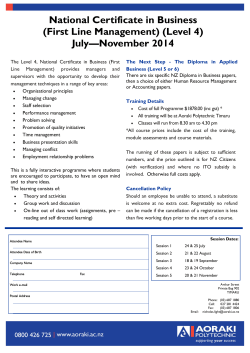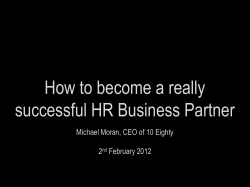
GET ONL E IN
AU ST RA LIA williams CE NG SA A M GE PL L E EA PA R GE NI S NG 2ND ASIA–PACIFIC EDITION McWILLIAMS GET ONLINE Other great ways to help you study include games, VIDEOS, CASES, FLASHCARDS, PODCASTS, quizzes AND MORE. View card inside and access cengageBRAIN.Com planetvdesigns@gmail.com Instructors: resources help make teaching easier – ask your Sales Representative for details Join us on the Internet | Cengage Learning — www.cengagelearning.com.au ISBN: 978-0170225892 For learning solutions, visit cengage.com.au 9 780170 225892 mgmt2_sb_25892_cvr.indd 1-3 PR O PE RT Y OF At 2ND ASIA–PACIFIC EDITION What’s inside: MS A I L L I W MS A I L L I McW • Core management concepts! • An innovative approach to teaching and learning management principles. • Learn anywhere with tear-out chapter review cards. • PLUS: interactive online study tools for today’s student. Online resources available only with the purchase of a NEW book! 3/06/13 3:02 PM Part 1: Introduction to management 2 Planning AU ST Part 2: RA L IA 1: Management..................................................... 2 2: History of management.................................... 18 3: Organisational environments and cultures........ 36 4: Ethics and social responsibility. . ...................... 54 72 CE NG SA A M GE PL L E EA PA R GE NI S NG 5: Planning and decision making......................... 72 6: Organisational strategy. . ................................. 90 7: Innovation and change. . ................................ 110 8: Global management...................................... 126 Brief contents Part 3: Organising 146 9: Designing adaptive organisations.................. 146 10: Managing teams. . .......................................... 164 11:Managing people: human resource management................................................. 180 Part 4: Leading212 Shutterstock.com/Rtimages PR OP ER T Y OF 12:Motivation.................................................... 212 13:Leadership............................................... 230 14: Managing communication.............................. 248 Part 5: Controlling264 15:Control......................................................... 264 16: Managing information................................... 280 17:M anaging service and manufacturing operations.................................................... 298 Endnotes 316 Index 337 Chapter in review cards 347 iii 00_mgmt_2_sb_25892_txt_3pp.indd 3 11/06/13 11:35 AM Ancient managers AU ST RA LIA Sumerian priests developed a formal system of writing (scripts) that allowed them to record and keep track of the goods, flocks and herds of animals, coins, land and buildings that were contributed to their temples. Furthermore, to encourage honesty in such dealings, the Sumerians instituted managerial controls that required all priests to submit written accounts of the transactions, donations and payments they handled to the chief priest. Just like clay or stone tablets and animal-skin documents, these scripts were first used to manage the business of Sumerian temples.10 The evolution of management PR iStockphoto/Dave Herriman OP E RT Y OF CE NG SA A M GE PL L E EA PA R GE NI S NG During the Industrial Revolution (late eighteenth century into the nineteenth century), however, jobs and organisations changed dramatically.5 First, thanks to the availability of power (steam engines and later electricity), low-paid, unskilled labourers running machines began to replace high paid, skilled artisans who made entire products by themselves, by hand. This new mass-production system was based on a division of labour: each worker, interacting with machines, performed separate, highly specialised tasks that were but a small part of all the steps required to make manufactured goods. While workers focused on their singular tasks, managers were needed to effectively coordinate the different parts of the production system and optimise its overall performance. Productivity skyrocketed at companies that understood this. For example, at the Ford Motor Company, the time required to assemble a car dropped from 12.5 manhours to just 93 minutes.6 Second, jobs existed in large, formal organisations where hundreds, if not thousands, of people worked under one roof, instead of in fields, homes or small shops.7 In 1884, Australian industrialist H.V. McKay, who first started out working in a blacksmiths in Ballarat, established the Sunshine Harvester Works in what are now the western suburbs of Melbourne. Sunshine Harvester Works was at one time the largest manufacturer in Australia with over 3000 employees around 1906.8 By 1913, Henry Ford employed 12 000 employees in just his Highland Park, Michigan, factory in the US. With individual factories employing so many workers under one roof, companies now had a strong need for disciplinary rules (to impose order and structure). For the first time, they needed managers who knew how to organise large groups, work with employees and make good decisions. Before 1880, business educators taught only basic bookkeeping and secretarial skills, and no one published books or articles about management.11 Today, if you have a question about management, you can turn to dozens of academic journals, hundreds of business school and practitioner journals (such as Harvard Business Review, Sloan Management Review, Journal of Management and Organization and the Academy of Management Executive) and thousands of books and articles. In the next four sections, you will learn about other important contributors to the field of management and how their ideas shaped our current understanding of management theory and practice. After reading the next four sections, which review the different schools of management thought, you should be able to: 2.2 explain the history of scientific management 2.3 discuss the history of bureaucratic and administrative management 2.4 explain the history of human relations management 2.5 discuss the history of operations, information, systems and contingency management. Learning objective 2 2.2 Scientific management Australians spend more than 160 hours a year commuting to and from work. That’s roughly the equivalent of over four full-time work weeks.9 Before scientific management, organisational decision making could best be described as ‘seat-of-the-pants’. Decisions were made haphazardly without any systematic study, thought or collection of information. If the ‘managers’ hired by the company founder or owner decided that workers should work twice as fast, little or no thought was given Chapter Two \ History of management 02_mgmt_2_sb_25892_txt.indd 21 21 13/12/13 9:53 AM TY ER PR OP 2006-2013 99designs OF CE NG SA A M GE PL L E EA PA R GE NI S NG are intentionally composed of employees from different functional a team composed of employees from different areas of the organisation.25 Because functional areas of the their members have different organisation functional backgrounds, education and experience, cross-functional ❉ virtual team a team composed of teams usually attack problems geographically and/or from multiple perspectives and organisationally dispersed generate more ideas and alternative co workers who use solutions, all of which are especially telecommunications and information technologies important when trying to innovate to accomplish an or do creative problem solving.26 organisational task Cross-functional teams can be used almost anywhere in an organisation and are often used in conjunction with matrix and product organisational structures (see Chapter 9). They can also be used either with part-time or temporary team assignments or with full-time, long-term teams. Cessna, which manufactures aeroplanes, created crossfunctional teams for purchasing parts. With workers from purchasing, manufacturing engineering, quality engineering, product design engineering, reliability engineering, product support and finance, each team addressed make-versus-buy decisions (make it themselves or buy from others), sourcing (who to buy from), internal plant and quality improvements and the external training of suppliers to reduce costs and increase quality.27 Virtual teams are groups of geographically and/or organisationally dispersed co-workers who use a combination of telecommunications and information technologies to accomplish an organisational task.28 When it comes to virtual teams, Melbourne’s 99Designs is a standout example. A design company working with a crowdsourcing approach, 99Designs has offices in Melbourne, Berlin and San Francisco. As they say on their web page ‘From our gallerystyle offices in Melbourne to the piers of San Francisco, we’ve got the most talented and passionate staff . . . ’ Growing from just three staff (the founders) to 70 in just under four years, 99Designs keeps the team together across three continents and many time zones through the use of technology.29 The principal advantage of virtual teams is their flexibility. Employees can work with each other regardless of physical location, time zone or organisational affiliation.31 Because the team members don’t meet in a physical location, virtual teams also find it much easier to include other key stakeholders, such as suppliers and customers. Plus, virtual teams have certain efficiency advantages over traditional team structures. Because the teammates do not meet face-to-face, a virtual team typically requires a smaller time commitment than a traditional team does.32 A drawback of virtual teams is that the team members must learn to express themselves in new contexts.33 The give-and-take that naturally occurs in face-to-face meetings is more difficult to achieve through videoconferencing or other methods of virtual teaming. Indeed, several studies have shown that physical proximity enhances information processing in teams.34 Therefore, some companies bring virtual team members together in offices or special trips on a regular basis to try to minimise these problems. Project teams are created to complete specific, one-off projects or tasks within a limited time.35 Project teams are often used to develop new products, significantly improve existing products, roll out new information systems or build new factories or offices. The ❉ project team project team is typically led by a a team created to project manager, who has the overall complete specific, oneresponsibility for planning, staffing time projects or tasks and managing the team, which within a limited time usually includes employees from different functional areas. Effective project teams demand both individual and collective responsibility.36 One advantage of project teams is that drawing employees from different functional areas can reduce or eliminate communication barriers. In turn, as long as team members feel free to express their ideas, thoughts and concerns, free-flowing communication encourages cooperation among separate departments and typically speeds up the design process.37 Another advantage of project teams is their flexibility. When projects are finished, project team members either move on to the next project or return to their functional units. For example, publication of this book required designers, editors, page compositors and web designers, among others. When the task was finished, these people applied their skills to other textbook projects. Because of this flexibility, project teams are often used with the matrix organisational designs discussed in Chapter 9. AU ST RA LIA Cross-functional teams ❉ cross-functional team 170 Part 3 \ Organising 10_mgmt_2_sb_25892_txt.indd 170 13/12/13 10:17 AM Key terms Moore’s law The prediction that every 18 months, the cost of computing will drop by 50 per cent as computerprocessing power doubles. LO 1 Strategic importance of information The first company to use new information technology to substantially lower costs or differentiate products or services often gains first-mover advantage, higher profits and larger market share. Creating a first-mover advantage can be difficult, expensive and risky, however. According to the resource-based view of information technology, sustainable competitive advantage occurs when information technology adds value, is different across firms and is difficult to create or acquire. Raw data Facts and figures. AU Does the information technology create value? Information First-mover advantage The strategic advantage that companies earn by being the first to use new information technology to substantially lower costs or to make a product or service different from that of competitors. Acquisition cost The cost of obtaining data that you don’t have. Processing cost The cost of turning raw data into usable information. Storage cost No NG SA A M GE PL L E EA PA R GE NI S NG Useful data that can influence people’s choices and behaviour. Competitive disadvantage No Yes Is the information technology different across competing firms? The cost of accessing already-stored and processed information. Communication cost CE The cost of transmitting information from one place to another. Bar code OF A visual pattern that represents numerical data by varying the thickness and pattern of vertical bars. Radio frequency identification (RFID) tags TY Tags containing minuscule microchips that transmit information via radio waves and can be used to track the number and location of the objects into which the tags have been inserted. ER Electronic scanner OP An electronic device that converts printed text and pictures into digital images. Optical character recognition PR The ability of software to convert digitised documents into ASCII (American Standard Code for Information Interchange) text that can be searched, read and edited by word processing and other kinds of software. Processing information Transforming raw data into meaningful information. 16 C managing information 20_mgmt_2_sb_25892_txt_3pp.indd 37 Yes Competitive parity The cost of physically or electronically archiving information for later use and retrieval. Retrieval cost ST RA LIA iStockphoto/Kizikayaphotos review Learning objectives (LO) Is it difficult for another firm to create or buy the information technology? No Temporary competitive advantage Yes Sustained competitive advantage Using information technology to sustain a competitive advantage Source: Adapted from F. J. Mata, W. L. Fuerst & J. B. Barney, ‘Information Technology and Sustained Competitive 05-150 EX17-02 Advantage: A Resource-Based Analysis’, MIS Quarterly 19, no. 4 (December 1995): 487–505. Reprinted by special permission by the Society for Information Management and the Management Information Systems Research Center at the University of Minnesota. LO 2 Characteristics and costs of useful information Raw data are facts and figures which do not become information until they are in a form that can affect decisions and behaviour. For information to be useful, it has to be reliable and valid (accurate), of sufficient quantity (complete), pertinent to the problems you’re facing (relevant) and available when you need it (timely). Useful information does not come cheaply. The five costs of obtaining good information are the costs of acquiring, processing, storing, retrieving and communicating information. LO 3 Capturing, processing and protecting information Electronic data capture (bar codes, radio frequency identification [RFID] tags, scanners and optical character recognition) is much faster, easier and cheaper than manual data capture. Processing information means transforming raw data into meaningful information that can be applied to business decision making. Data mining helps managers with this transformation by discovering 5/06/13 5:57 PM
© Copyright 2025





















